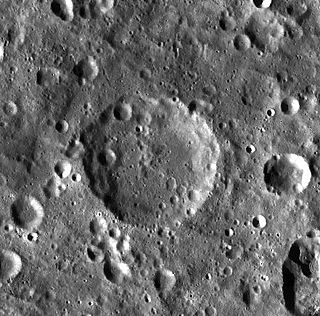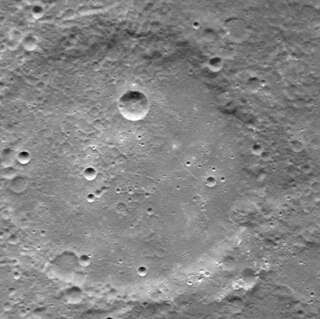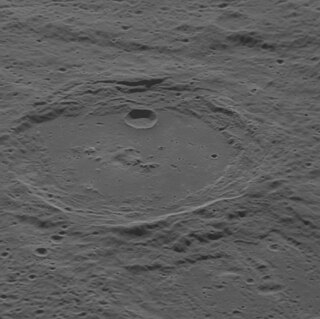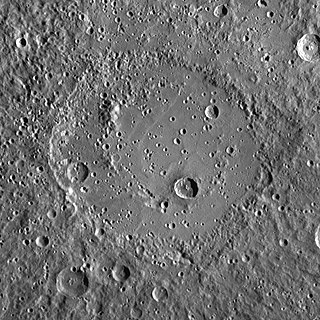
Apollo, also called the Apollo basin, is an enormous impact crater located in the southern hemisphere on the far side of the Moon. This formation dwarfs the large crater Oppenheimer that is located next to the western rim. The crater Barringer lies across the northern wall. To the southeast is the crater Anders, and Kleymenov is just to the east of the rim.

Fabry is a large lunar impact crater of the form termed a walled plain. It is located on the far side of the Moon, just beyond the northeastern limb. Parts of this area are sometimes brought into view by the effects of libration, but the terrain is seen from the edge and so not much in the way of detail can be observed.

Nasireddin is a lunar impact crater that lies in the rugged terrain in the southern part of the Moon's near side. This crater overlaps two older formations, intruding into the crater Miller to the north and Huggins to the west. To the east of Nasireddin is the much larger walled plain Stöfler.

Chevallier is a lunar impact crater that is located in the northeastern part of the Moon's near side, about a crater diameter east-southeast of the prominent crater Atlas. To the south-southeast of Chevallier is the flooded crater Shuckburgh. Chevallier was named by the IAU in 1935.

Freundlich is a lunar impact crater that is located on the far side of the Moon. It lies midway between the craters Trumpler to the north-northwest and the irregular Buys-Ballot to the south-southeast. This crater has a circular rim that is more heavily eroded at the northern and southern ends. Groups of craters lie across the floor to the southeast and the north, and individual small craters lie elsewhere within the interior. The crater was named after Erwin Freundlich by the IAU in 1970.

Africanus Horton is a circular impact crater on Mercury. It was named by the IAU in 1976, after Africanus Horton, a Creole African nationalist writer and an esteemed medical surgeon in the British Army from Freetown, Sierra Leone.

Matisse is an impact crater on the southern hemisphere of Mercury. Matisse takes its name from the French artist Henri Matisse, and it was named by the IAU in 1976.

Qi Baishi is a crater on Mercury. The crater was named after famed Chinese painter Qi Baishi. The crater has an asymmetric pattern of ejecta rays, which formed by an object traveling to the east or to the west and impacting Mercury's surface at a very low incidence angle. However, Qi Baishi crater is still roughly circular, which is in contrast to the elongated shape of neighboring Hovnatanian crater.

Hauptmann is a crater on Mercury. It has a diameter of 118 kilometers. Its name was adopted by the International Astronomical Union (IAU) in 1985. Hauptmann is named for the German playwright Gerhart Hauptmann, who lived from 1862 to 1946.

Khansa is a crater on Mercury. Its name was adopted by the International Astronomical Union (IAU) in 1976. Khansa is named after the Arab poet al-Khansa, who lived in the 6th century CE.

Martial is a crater on Mercury. It has a diameter of 51 kilometers. Its name was adopted by the International Astronomical Union in 1979. Martial is named for the ancient Roman poet Martial, who lived from 40 to 103.

Mussorgskij is a crater on Mercury. Its name was adopted by the International Astronomical Union (IAU) in 1979. Mussorgskij is named for the Russian composer Modest Mussorgsky, who lived from 1839 to 1881. The crater was first imaged by Mariner 10 in 1974.

McLaughlin Crater is an old crater in the Oxia Palus quadrangle of Mars, located at 21.9°N 337.63°E. It is 90.92 km (56.50 mi) in diameter and 2.2 km (1.4 mi) deep. The crater was named after Dean B. McLaughlin, an American astronomer (1901-1965). The Mars Reconnaissance Orbiter has found evidence that the water came from beneath the surface between 3.7 billion and 4 billion years ago and remained long enough to make carbonate-related clay minerals found in layers. McLaughlin Crater, one of the deepest craters on Mars, contains Mg-Fe clays and carbonates that probably formed in a groundwater-fed alkaline lake. This type of lake could have had a massive biosphere of microscopic organisms.

Ellington is a crater on Mercury named after Duke Ellington, an American composer, pianist, and leader of a jazz orchestra. It was named by the IAU in 2012.

Villa-Lobos is a crater on Mercury. Its name was adopted by the International Astronomical Union (IAU) on September 25, 2015. Villa-Lobos is named for the Brazilian composer Heitor Villa-Lobos.

Anguissola is a crater on Mercury. It has a diameter of 35.41 kilometres. Its name was adopted by the International Astronomical Union (IAU) on August 4, 2017. Anguissola is named for the Italian painter Sofonisba Anguissola.

Flaiano is a crater on Mercury. It has a diameter of 43 kilometres. Its name was adopted by the International Astronomical Union (IAU) on March 15, 2013. Flaiano is named for the Italian writer Ennio Flaiano.


















